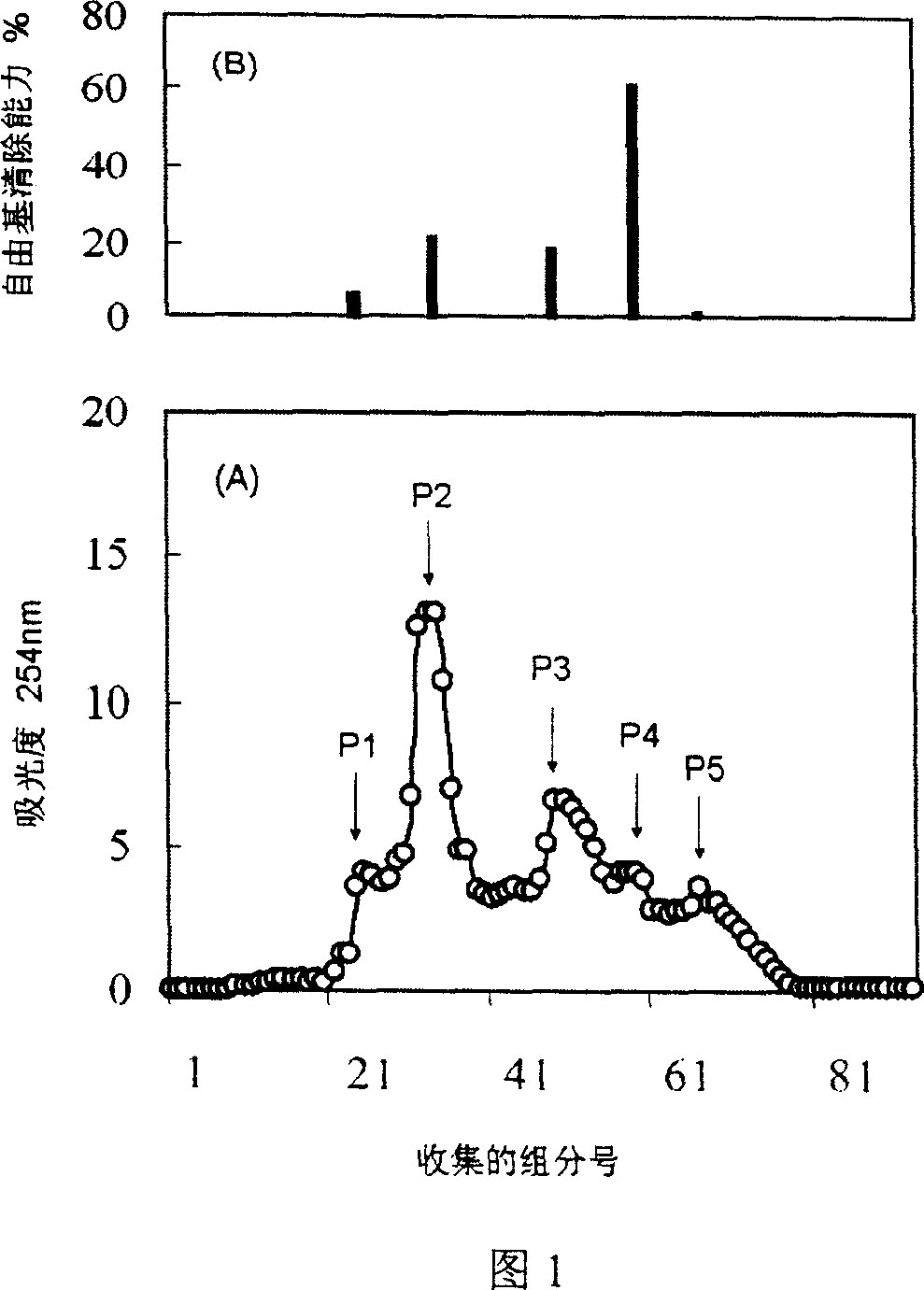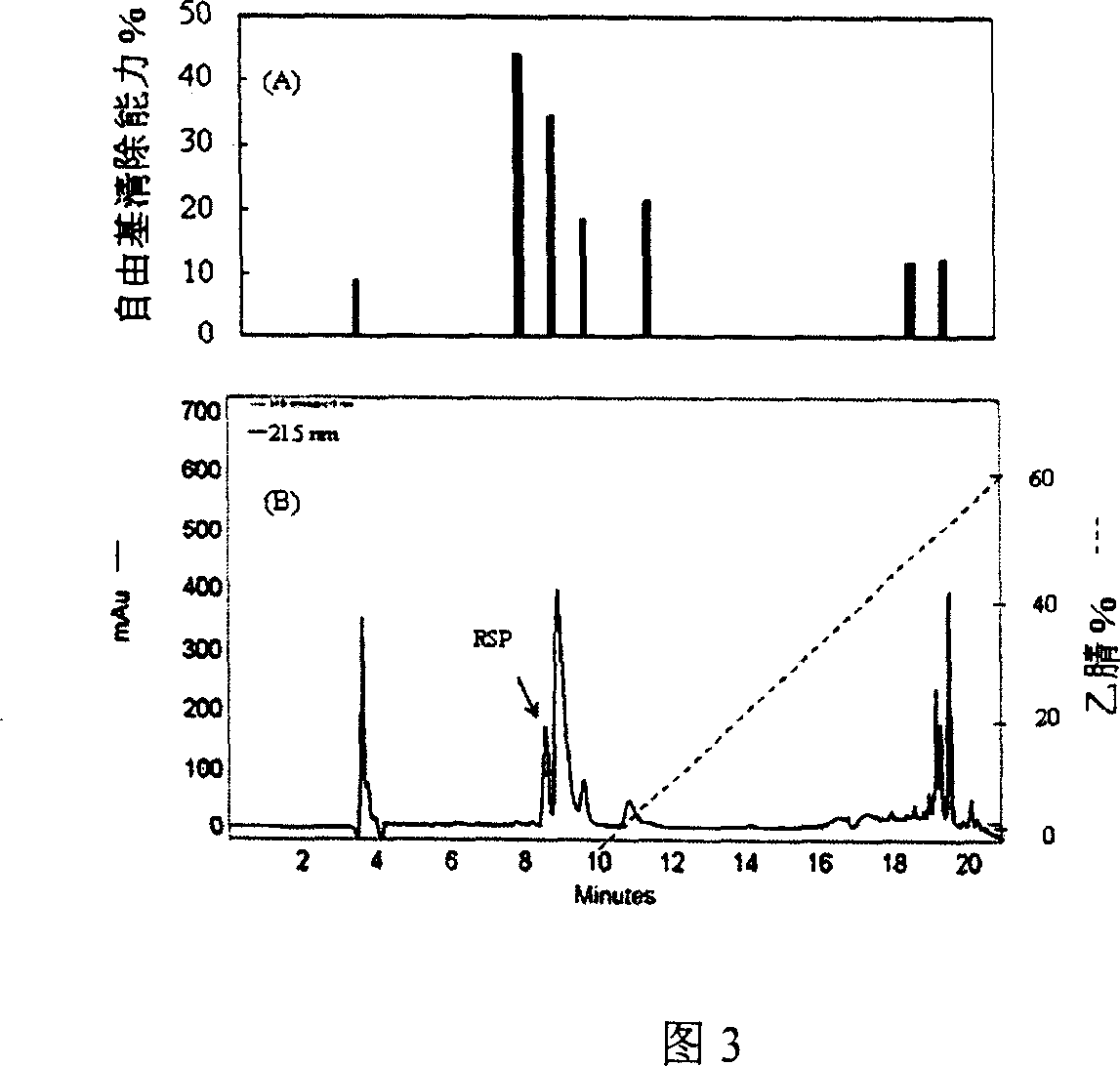Anti-titanium oxide from collagen and its use
A technology of collagen and antioxidant peptides, applied in peptide/protein components, medical preparations containing active ingredients, peptides, etc., can solve the problem of losing antioxidant activity
- Summary
- Abstract
- Description
- Claims
- Application Information
AI Technical Summary
Problems solved by technology
Method used
Image
Examples
Embodiment 1
[0061] Example 1. Test of Antioxidative Ability of Antioxidant Peptide Mixture Obtained by Hydrolyzing Collagen with Protease At 37°C, the collagen powder of pigskin was mixed with purified water so that the weight percentage of collagen in the mixture was 5wt %, adjust the pH value of collagen to 2.0 with 6N hydrochloric acid, then add pepsin (pepsin) (the weight ratio of collagen and protease is 2500: 1, carry out hydrolysis reaction 24 hours; ℃ for 5 minutes, and then boil for another 3 minutes to stop the enzymatic hydrolysis reaction.
[0062] Then, continue to carry out mixed enzymolysis with pronase and bovine trypsin on this basis: adjust the pH value of above-mentioned pepsin hydrolyzate to be 7.5, enzyme (the weight ratio of pronase and bovine trypsin is 1: 1) and substrate The ratio is 2 / 125, the hydrolysis temperature is 37°C, and the hydrolysis time is 24 hours. At the end of the hydrolysis, the hydrolyzate is boiled for 3 minutes to inactivate the enzyme, and a p...
Embodiment 2
[0065] Example 2, further separation and identification of 4 antioxidant peptides of the present invention
[0066] Dissolve the lyophilized powder obtained in Example 1 with a small amount of deionized water, and separate it with a gel filtration chromatographic column SephadexLH-20 (2.5×80cm), using deionized water as the mobile phase, and the peptides in the mixture are eluted sequentially , detect the concentration of peptide at 254nm, as shown in Figure 1 (A), measure the antioxidant activity of the eluent corresponding to each absorption peak, as shown in Figure 1 (B), collect the antioxidant activity higher than 50% Component P4, then lyophilized into powder with a lyophilizer
[0067] The lyophilized powder of component P4 was dissolved with 0.5M tris-HCl buffer solution (pH 8.3), and loaded onto the DEAE-Sephadex A-25 (Cl-type, Sigma, 2.0×35cm) chromatogram equilibrated with the buffer solution Separation and purification on the column. Use 0.5M tris-HCl buffer to e...
Embodiment 3
[0070] Component D was separated and purified by the same method. Two antioxidant active components were separated. The amino acid sequence of the peptide was identified by tandem chromatography (MS / MS) and amino acid sequence analyzer, and the amino acid sequence of the antioxidant peptide was identified as Leu-Gln-Gly-Met (molecular weight 447.2) and Leu-Gln-Gly-Met -Hyp (molecular weight 560.3). Embodiment 3, use antioxidant peptide of the present invention to add in soy sauce as antioxidant
[0071] Soy sauce production formula (weight ratio) is as follows:
[0072] A Raw soy sauce, 5%, main ingredient;
[0073] B Caramel pigment, according to production needs (about 0.05%);
[0074] C Monosodium glutamate and [I+G], the two are mixed at a weight ratio of 35-45:1, 0.6%-0.7%;
[0075] D Collagen-derived antioxidant peptide, added 0.5%, can be used as a nutritional enhancer and freshness aid at the same time, increasing the amino acid content of the product and increasing...
PUM
 Login to View More
Login to View More Abstract
Description
Claims
Application Information
 Login to View More
Login to View More - R&D
- Intellectual Property
- Life Sciences
- Materials
- Tech Scout
- Unparalleled Data Quality
- Higher Quality Content
- 60% Fewer Hallucinations
Browse by: Latest US Patents, China's latest patents, Technical Efficacy Thesaurus, Application Domain, Technology Topic, Popular Technical Reports.
© 2025 PatSnap. All rights reserved.Legal|Privacy policy|Modern Slavery Act Transparency Statement|Sitemap|About US| Contact US: help@patsnap.com



